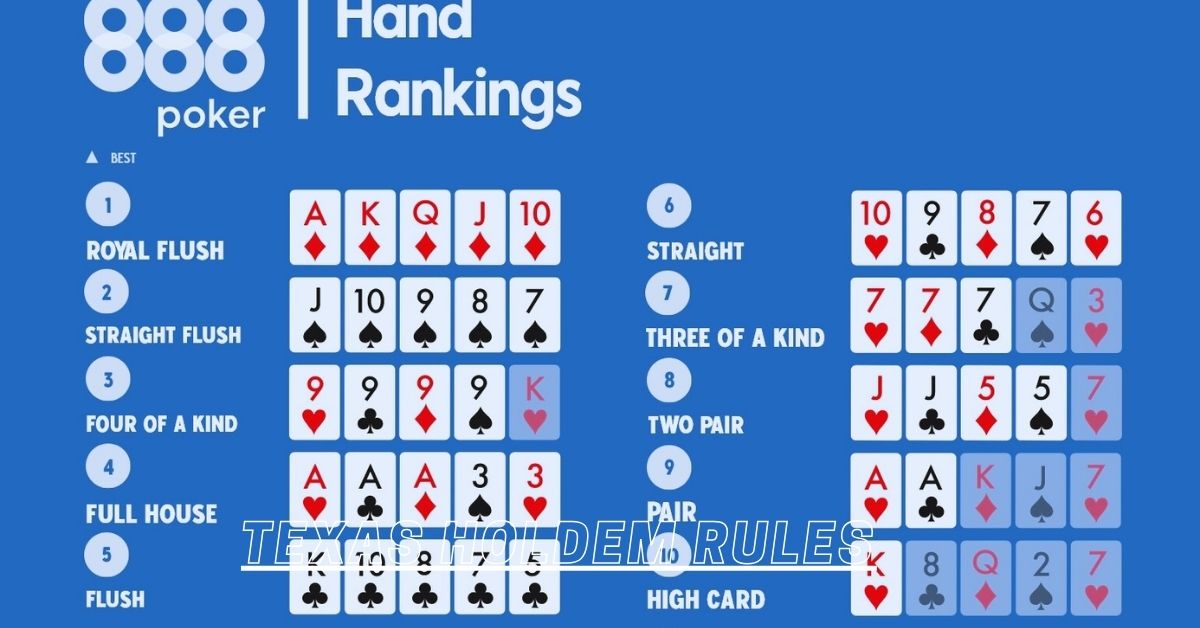Introduction
Texas Hold’em is one of the most popular variations of poker, renowned for its strategic depth and fast-paced action. Understanding the Texas Holdem rules is essential for anyone looking to play this exciting game, whether in casinos, home games, or major tournaments worldwide. This guide will walk you through the fundamental rules of Texas Hold’em, helping you understand how to play and win.
The Objective of the Game
The primary objective of Texas Hold’em is to win chips by either having the best hand at a showdown or by convincing other players to fold. According to the Texas Holdem rules, each player is dealt two private cards (known as “hole cards”) that belong to them alone. Five community cards are dealt face-up on the “board,” and players use these in conjunction with their hole cards to make the best possible five-card poker hand.
Basic Game Setup
Number of Players
Texas Hold’em can be played with 2 to 10 players. The Texas Holdem rules typically designate a fixed number of players in ring games, but in tournament settings, the number of participants can vary.
The Dealer Button
A crucial element in the Texas Holdem rules is the dealer button, a small disc that rotates around the table clockwise after each hand. The button signifies the dealer’s position and determines the order of betting. While the dealer is a position in home games, in casinos, a professional dealer manages the cards, and the button rotates to indicate the dealer’s position.
Blinds
Before the hand begins, the Texas Holdem rules require the two players to the left of the dealer button to post forced bets called the small blind and big blind. The small blind is posted by the player immediately to the left of the dealer button, while the big blind is posted by the player two positions to the left. The big blind is typically twice the size of the small blind.
The Deal
Hole Cards
According to the Texas Holdem rules, each player is dealt two private cards face down, known as “hole cards.” These cards are only visible to the player who receives them and are kept secret from other players.
Community Cards
Five community cards are dealt face-up on the board in three stages: the flop, the turn, and the river. These community cards are shared among all players and can be used in combination with their hole cards to form the best possible hand.
Betting Rounds
Pre-Flop
The first betting round occurs after players receive their hole cards but before any community cards are dealt. According to the Texas Holdem rules, players have the option to call (match the big blind), raise (increase the bet), or fold (discard their hand).
The Flop
Three community cards are dealt face-up on the board. The second betting round begins with the player to the left of the dealer button. Players can check (pass the action), bet, call, raise, or fold, following the Texas Holdem rules.
The Turn
A fourth community card, known as the “turn,” is dealt face-up. The third betting round starts with the player to the left of the dealer button. Betting options remain the same as in previous rounds, under the Texas Holdem rules.
The River
The fifth and final community card, called the “river,” is dealt face-up. The final betting round begins with the player to the left of the dealer button. Players can now make their final decisions on betting, checking, raising, or folding, as per the Texas Holdem rules.
The Showdown
After the final betting round, if more than one player remains, a showdown occurs. Players reveal their hole cards, and the best five-card hand is determined using their hole cards and the community cards. The player with the best hand wins the pot. In the event of a tie, the pot is split between the tied players, following the Texas Holdem rules.
Betting Strategies
Starting Hand Selection
One of the most critical aspects of Texas Hold’em strategy is selecting the right starting hands. Premium hands like pocket aces, kings, queens, and ace-king are strong starting hands, while lower-ranked hands should be played more cautiously.
Position and Bluffing
Position is crucial in Texas Hold’em. Players in later positions have more information about their opponents’ actions, which can be advantageous for making strategic decisions. Bluffing is also an essential strategy, where players bet or raise with a weak hand to force opponents to fold.
Reading Opponents
Paying attention to opponents’ betting patterns, body language, and tendencies can provide valuable information about their hands. Observing their behavior and making educated guesses can help you make better decisions.
Betting Limits
Texas Hold’em games come in various formats, each with specific rules:
No-Limit
In No-Limit Texas Hold’em, there is no maximum bet, and players can bet any amount of chips they have in front of them. This format allows for significant swings in chip stacks and can lead to dramatic changes in the game.
Pot-Limit
In Pot-Limit Texas Hold’em, the maximum bet is determined by the size of the current pot. Players can bet up to the amount of the pot, which increases as the hand progresses.
Fixed-Limit
In Fixed-Limit Texas Hold’em, the betting amounts are predetermined. There are set limits for each betting round, which can make the game more predictable and controlled.
Online vs. Live Play
Online Poker
Online Texas Hold’em offers convenience and accessibility, allowing players to participate from the comfort of their homes. Online platforms often feature various game types, limits, and tournament options.
Live Poker
Live Texas Hold’em provides a social experience with face-to-face interaction. Players can read physical tells and enjoy the atmosphere of a casino or home game.
Common Mistakes to Avoid
Overvaluing Hands
One common mistake is overvaluing starting hands or continuing with a weak hand. It’s essential to assess the strength of your hand concerning the community cards and the betting action.
Poor Bankroll Management
Effective bankroll management is crucial for long-term success. Avoid risking more chips than you can afford to lose, and adjust your play based on your chip stack and the game’s dynamics.
Not Adapting to Opponents
Failing to adapt your strategy based on opponents’ behavior and tendencies can hinder your success. Adjust your play style to counteract their strategies and take advantage of their weaknesses.
Conclusion
Texas Holdem is a dynamic and exciting game that combines skill, strategy, and psychology. Understanding the Texas Holdem rules, hand rankings, and betting structures is essential for success. By mastering these fundamentals and avoiding common mistakes, you can enhance your gameplay and increase your chances of winning. Whether you’re playing for fun or in a competitive setting, Texas Hold’em offers endless opportunities for enjoyment and challenge.
Read More: Discover Pikruos – Plan the Perfect Getaway





